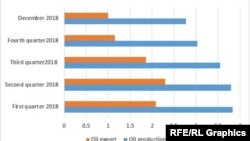Iran’s crude oil production plunged to 2.754 million barrels per day (mb/d) in January 2019, about 1.064 million barrels per day less than in May 2018, when the United States withdrew from the 2015 nuclear agreement, OPEC said February 12.
Iran’s January oil production is the lowest level since October 2014, during the tightest period of previous round of international sanctions (2012-2016), imposed on Iran’s oil exports.
The reason for the decline in production is Iran's inability to export its oil and oil products in the face of U.S> sanctions.
Although the U.S. reimposed oil export sanctions last November, it gave a six-month exemption or wavier to eight friendly countries: China, India, Japan, South Korea, Taiwan, Turkey, Italy and Greece to continue buying a restricted quantity of Iranian oil, but it is uncertain if Washington will extend the waivers beyond May.
Currently, Iran exports a little more than 1 mb/d of crude oil, less than a half of what it sold last May and the rest of its production is used domestically.
Less oil exports than it expected and the possibility of waivers not being extended to major buyers are more bad news for the Iranian government which has based its next fiscal year’s (starts March 21) budget on 1.54 mb/d oil export. Even 1.5 million barrels puts Iran's economy in a bind and anything less than that will make the budget hard to manage.
Hassan Rouhani’s government would face even a much worse scenario if the U.S. decides to bring Iran’s oil exports down to zero. Recently, Central Bank of Iran released a report, putting the nine-month budget deficit (March 21-December 22, 2018) at above 450 trillion rials, or $10.73 billion, based on official USD rate: $1/42,000 rials.
OPEC cuts production as U.S. shale output rises
OPEC says its members reduced production by about 0.8 mb/d to 32.806 mb/d: “Demand for OPEC crude in 2018 stood at 31.6 mb/d, 1.3 mb/d lower than the 2017 level and in 2019 the demand would decrease further 1 mb/d”.
OPEC and its non-member allies headed by Russia agreed late-2018 to decrease production by 1.2 mb/d during first half of 2019 to push oil prices high. OPEC members (excluding Iran, Venezuela and Libya) are responsible for two thirds of production cut.
Currently Brent benchmark price stands at $62.7/barrel, about 16% above the early January level.
Non-OPEC production growth, especially U.S. shale boom has left less room for OPEC members to keep their production high.
Meanwhile, the U.S. Energy Information Administration (EIA) released a report, saying that US crude oil production averaged 12 mb/d in January, up 90,000 b/d from December. EIA forecasts U.S. crude oil production to average 12.4 mb/d in 2019 and 13.2 mb/d in 2020.
The country’s production level was 10.93 mb/d in 2018, about 18% more than 2017.





